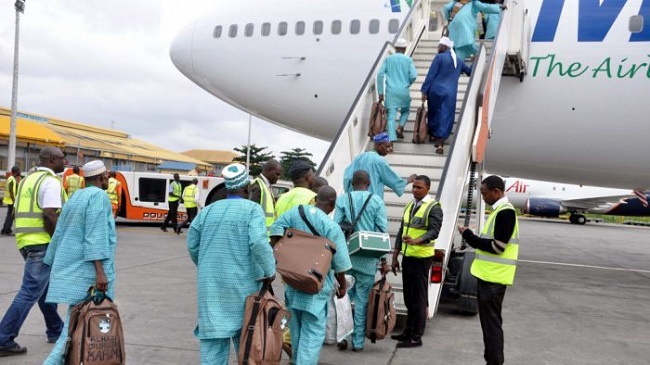THE airlift of Nigerian pilgrims to Saudi Arabia for the 2023 Hajj is progressing amidst challenges here and there. The speed of the airlift contradicts the operational limitations brought upon by longer travel hours, use of low-capacity aircraft by some appointed Hajj carriers and the visa processing logjam caused by bureaucracy within the frame of the international forex transaction at the Central Bank of Nigeria (CBN).
From messages received from intending pilgrims via Hajj Reporters’ social media platforms, one may be tempted to think that Nigerian pilgrims are yet to arrive in Saudi Arabia for this year’s Hajj. There is anxiety among intending pilgrims still in Nigeria as to whether they will be airlifted to Saudi Arabia before the closure of airports, considering the Hajj 2022 experience.
However, despite the apprehension on the part of the intending pilgrims, in 21 days, 49,246 pilgrims (as of the time of writing this piece) have been transported from Nigeria to Saudi Arabia in an exercise that involved 117 flight operations from nine airports.
Taking an objective view of the Hajj airlift requires the assessment of the roles of all stakeholders, including NAHCON, as the apex Hajj regulatory body; states’ Muslim pilgrims welfare boards, the CBN, appointed Hajj officials working at various embarkation points, air carriers and security and screening agencies, in the airlift process.
The Hajj exercise is a multifaceted operation where success and failure depend on several variables. For example, it is the responsibility of NAHCON to ensure timely implementation of procedures to process visas for applicants subject to timely payment of Hajj fare by intending pilgrims and early transfer of such to NAHCON as and when requested. The Nigeria Immigration Service is to provide the e-passport as and when due to the applicant-pilgrims. The Nigeria Customs Service, National Drug Law Enforcement Agency (NDLEA), the National Agency for Food and Drug Administration and Control (NAFDAC), the Port Health Authority and security agencies play critical roles in the screening of pilgrims at the embarkation points.
By and large, NAHCON’s non-reliance on first options might have yielded a positive result as seen in the progress recorded so far. However, IHR will continue to keep tabs on the appointed airlines, especially those who failed to operate with the aircraft specified in the airlift agreements they signed with NAHCON.
Airlifting over 47,000 pilgrims in 110 flights within 20 days from nine embarkation points shows that NAHCON has learnt something from the 2022 Hajj airlift misfortune.
Also worthy of note is the decision by NAHCON to increase the number of air carriers this year. While there were only three carriers last year, namely, Max Air, Azman and Flynas, the number was increased to seven this year with the introduction of Air Peace, Aero Contractors, Arik Air and Valuejet airlines. This has given the states options of carriers to choose from and has enhanced healthy competition.
This year, NAHCON didn’t wait till the 11th hour before invoking and implementing what I call ‘internal rescue’ of airlines which are lagging. NAHCON seems to have grasped the knives of past years’ mistakes by the handle.
The ‘internal rescue’ I referred to occurs when an appointed airline fails or delays beyond certain hours to position its aircraft to airlift its allotted pilgrims or when such an airline indicates that it may not be available for the scheduled airlift. In such situations, NAHCON directs another airline to fly the allotted pilgrims of the troubled airline to save pilgrims from distress.
The inaugural flight this year was an ‘internal rescue’ operation by Max Air because Nasarawa pilgrims are allocated to Aero Contractors. The first batch of Jigawa pilgrims airlifted by Max was also a rescue operation due to delay by Azman Airline. Flynas also rescued Nasarawa pilgrims when Aero contractors failed to show up on schedule. Aero Contractors itself has airlifted Kaduna, FCT pilgrims in an ‘internal rescue’ operation
IHR is yet to receive complaints regarding the provision of BTA to pilgrims, which means that despite the reported scarcity of forex, the CBN has been able to discharge its obligations to pilgrims on BTA.
The 2023 outbound airlift is a remarkable improvement from last year based on the statistics so far, but I advise that all observed lapses be addressed immediately.
Of utmost importance is the safety of pilgrims and other people involved. Therefore, any “technical” issue affecting any airline must be thoroughly looked into and addressed according to global best practices. As is often said, the key word in aviation is safety.
NAHCON, states’ Muslim pilgrims welfare boards and air carriers must adhere strictly to the return manifest to allow those on the first leg out to be airlifted on the first leg in. Management of pilgrims’ hand luggage should be given priority to reduce the time frame of screening at King Abdulaziz International Airport.
The airlift continues.
- Muhammed is the National Coordinator of the Independent Hajj Reporters (IHR), an organisation that reports Hajj activities in Nigeria and Saudi Arabia.






